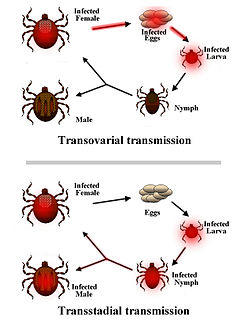
Transovarial or transovarian transmission (transmission from parent to offspring via the ovaries) occurs in certain arthropod vectors as they transmit pathogens from parent arthropod to offspring arthropod. For instance, Rickettsia rickettsii, carried within ticks, is passed on from parent to offspring tick by transovarial transmission. In contrast, Rickettsia prowazekii is not passed on by transovarian transmission because it kills the vector that carries it (human louse). This is the mechanism by which many Rickettsiae are maintained in their arthropod hosts through generations, which occurs also in aedes mosquito vector of the yellow fever virus and in phlebotomine sandflies that transmit pappataci fever.[1]
Richard Dawkins in "The Extended Phenotype" page 222 (1999 edition) notes that "bacterial endosymbionts of insects which are transmitted transovarially" share an interest in the "success of their host's gametes.....as well as the survival of their host's body." In this case, "the interest of the host genes and parasite genes might not be quite identical, but they would..... be very much closer than the case of fluke and snail." where host and parasite have different means of propagation into the next generation, and therefore more divergent interests.
Contrast with transstadial transmission.
References
- Murray, Patrick R.; Rosenthal, Ken S.; Pfaller, Michael A. Medical Microbiology, Fifth Edition. United States: Elsevier Mosby, 2005
- ^ Tesh, R.B. (1984). "Transovarial transmission of arboviruses in their invertebrate vectors". In K.F. Harris (ed.). Current topics in vector research. 2. pp. 57–76. ISBN 0-275-91433-X. Archived from the original on 2012-12-20.